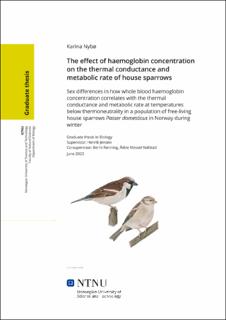| dc.contributor.advisor | Jensen, Henrik | |
| dc.contributor.advisor | Rønning, Bernt | |
| dc.contributor.advisor | Nafstad, Ådne Messel | |
| dc.contributor.author | Nybø, Karina | |
| dc.date.accessioned | 2023-07-27T17:19:41Z | |
| dc.date.available | 2023-07-27T17:19:41Z | |
| dc.date.issued | 2023 | |
| dc.identifier | no.ntnu:inspera:145860091:5713135 | |
| dc.identifier.uri | https://hdl.handle.net/11250/3081693 | |
| dc.description.abstract | Endoterme dyr (pattedyr og fuglar) brukar metabolsk energi for å halde kroppstemperaturen sin på eit stabilt nivå. Den termoregulatoriske kurva, først beskrive av Scholander og Irving, viser korleis den metabolske raten endrar seg etter kvart som temperaturen i omgjevnadane endrar seg for eit endotermt dyr. For populasjonar i kaldare område av verda, slik som i Noreg, er det spesielt relevant å sjå på termoregulering i kalde temperaturar, då dette er dei miljømessige tilhøva desse populasjonane normalt lever og fungerer i. Ein sentral parameter i den termoregulatoriske kurva er konduktans, som er stigningstalet til metabolismekurva i temperaturar som er lågare enn termonøytrale tilhøve. Slik seier den termoregulatoriske kurva noko om kor mykje metabolsk energi som trengst for å oppretthalde homeostasen når temperaturen i omgjevnadane endrar seg.
Hemoglobin er proteinet som transporterer oksygen i kroppen hos den store majoriteten av organismar. Sidan oksygen er det som driv dei metabolske prosessane i kroppen, er hemoglobinkonsentrasjonen ein viktig avgrensande faktor for kor raskt ei organisme kan ta opp oksygen frå lufta, transportere det ut til celler i kroppen, og gjere om energi som igjen kan brukast til rørsle, vedlikehald, reproduksjon, og termoregulering.
I denne masteroppgåva vert metabolsk rate og den termoregulatoriske kurva sett i samanheng med konsentrasjonen av hemoglobin i blodet hos ein populasjon av frittlevande gråsporv i Åfjord, Trøndelag, for å sjå om det var mogleg å finne nokon form for korrelasjon. Vaksne gråsporv vart fanga på fire ulike lokasjonar, og blodprøver vart tekne for å måle hemoglobinkonsentrasjon. Metabolismemålingar vart gjort ved bruk av indirekte kalorimetri.
Resultata viser at det er ein kjønnsskilnad når det kjem til korleis høgare konsentrasjonar av hemoglobin korrelerer med den termoregulatoriske kurva, med høgare stigningstal og metabolsk rate i kaldare temperaturar for hannar, og motsett for hoer, med eit lågare stigningstal og metabolsk rate i kalde temperaturar. Dersom hemoglobinkonsentrasjon reflekterer god fysisk helse, kan ein slik tilpassing tyde på to ulike strategiar for optimal energiallokering hos kjønna. Hannar, som har større behov for fysisk konkurranse, kan ha utvikla ein strategi som er i tråd med økt matinntak-hypotesen i livshistorieteori. Hoer, som på den andre sida kan ha større fordel av å spare energi til reproduksjon og egglegging, kan ha utvikla ein strategi som er i tråd med kompensasjonshypotesen, i livshistorieteori, der lav metabolisme er det mest gunstige. | |
| dc.description.abstract | Endotherms (mammals and birds) use metabolic energy to keep their body temperature at a stable level. The thermoregulatory curve, first described by Scholander and Irving, shows how the metabolic rate is changing with the ambient temperature for an endotherm. For populations in the colder parts of the world, such as Norway, it is especially interesting to look at the thermoregulation in cold temperatures, as this is the environmental conditions in which these populations normally live and function. A central parameter in the thermoregulatory curve is the thermal conductance, which is the slope of the curve in temperatures below thermoneutral conditions. Hence, thermal conductance reflects how much metabolic energy the animal needs to maintain homeostasis at certain ambient temperatures.
Haemoglobin is the oxygen transporting protein in the blood of most organisms. Because oxygen is driving the metabolic process in the body, the haemoglobin concentration is an important limiting factor in how fast an organism may take up oxygen from the air, transport it out to the cells in the body, and drive the energy turnover which again is used for movement, maintenance, reproduction, and thermoregulation.
In this master thesis, the metabolic rate, and the thermoregulatory curve of a population of house sparrows (Passer domesticus) in Åfjord, Norway was measured and seen in relation to haemoglobin concentration. Adult birds were captured in four different locations, and blood samples were taken to measure haemoglobin concentration. The metabolic measurements were done by using indirect calorimetry.
The results indicate that there is a sex difference in the effect of haemoglobin concentration on the thermal conductance in house sparrows at temperatures below thermoneutrality, where males have steeper slopes and higher metabolic rates in cold ambient temperatures, and females have the opposite response. If haemoglobin levels indicate good condition, then an adaptation like this may reflect two different strategies for optimal energy allocation for the two sexes. Males, who benefit from being able to compete physically, might have developed a strategy similar to the increased intake hypothesis in life history theory, where a high metabolic rate is beneficial. Females, on the other hand, who might benefit from saving energy for egg-laying and breeding, seem to have developed a strategy similar to the compensation hypothesis, where a low metabolic rate gives the highest fitness. | |
| dc.language | eng | |
| dc.publisher | NTNU | |
| dc.title | The effect of haemoglobin concentration on the thermal conductance and metabolic rate of house sparrows | |
| dc.type | Master thesis | |
